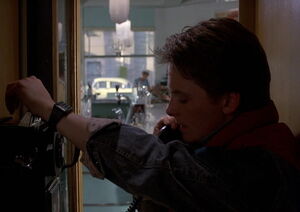(a little finetuning) Tag: rte-source |
(added a little more info) |
||
| Line 1: | Line 1: | ||
[[Image:MartyWatch.jpg|thumb|300px|Marty uses the payphone at Lou's Cafe.]] |
[[Image:MartyWatch.jpg|thumb|300px|Marty uses the payphone at Lou's Cafe.]] |
||
| + | |||
{{Quote|The prices ''[behind the counter in Lou's Cafe]'' fascinated Marty so completely that he must have stared at them long enough to convince [[Lou Caruthers|the counterman]] that he was undesirable. / "Whatever you're selling, kid, we don't want any," he said abruptly. / "I'm not selling anything," Marty replied. "I just want to use the telephone." |From ''[[Back to the Future novelization|Back to the Future]]'' by [[George Gipe]] (quote, page 86)}} |
{{Quote|The prices ''[behind the counter in Lou's Cafe]'' fascinated Marty so completely that he must have stared at them long enough to convince [[Lou Caruthers|the counterman]] that he was undesirable. / "Whatever you're selling, kid, we don't want any," he said abruptly. / "I'm not selling anything," Marty replied. "I just want to use the telephone." |From ''[[Back to the Future novelization|Back to the Future]]'' by [[George Gipe]] (quote, page 86)}} |
||
A '''payphone''' was a [[money|coin]]-operated public [[telephone]]. |
A '''payphone''' was a [[money|coin]]-operated public [[telephone]]. |
||
==History== |
==History== |
||
| − | There was a payphone situated in a booth in [[Lou's Cafe]] in [[1955]], |
+ | There was a payphone situated in a booth in [[Lou's Cafe]] in [[1955]], with local calls costing 5¢ (better known as a nickel). [[Marty McFly]] made use of the phone on [[November 5]] while he was making a call to Dr. [[Emmett Brown]], after having looked up his number in the [[telephone directory]]. However, Marty received no answer. |
A [[video telephone|video]] payphone bearing the [[AT&T]] logo was present in [[Courthouse Square]] in [[2015]], where [[Marty McFly, Jr.]] was spotted at one point through a [[binocular card]] used by Doc. |
A [[video telephone|video]] payphone bearing the [[AT&T]] logo was present in [[Courthouse Square]] in [[2015]], where [[Marty McFly, Jr.]] was spotted at one point through a [[binocular card]] used by Doc. |
||
| Line 12: | Line 13: | ||
===Actuality (2015)=== |
===Actuality (2015)=== |
||
| − | *Most outside payphones had been removed because of the prevalence of cellphones — something that'' Back to the Future Part II'' obviously didn't foresee, although bulky cellular telephones were in use in [[1989]]. |
+ | * Most outside payphones had been removed because of the prevalence of cellphones — something that'' Back to the Future Part II'' obviously didn't foresee, although bulky cellular telephones were in use in [[1989]]. |
==Appearances== |
==Appearances== |
||
Revision as of 18:07, 16 August 2018

Marty uses the payphone at Lou's Cafe.
- "The prices [behind the counter in Lou's Cafe] fascinated Marty so completely that he must have stared at them long enough to convince the counterman that he was undesirable. / "Whatever you're selling, kid, we don't want any," he said abruptly. / "I'm not selling anything," Marty replied. "I just want to use the telephone." "
- —From Back to the Future by George Gipe (quote, page 86)
A payphone was a coin-operated public telephone.
History
There was a payphone situated in a booth in Lou's Cafe in 1955, with local calls costing 5¢ (better known as a nickel). Marty McFly made use of the phone on November 5 while he was making a call to Dr. Emmett Brown, after having looked up his number in the telephone directory. However, Marty received no answer.
A video payphone bearing the AT&T logo was present in Courthouse Square in 2015, where Marty McFly, Jr. was spotted at one point through a binocular card used by Doc.
Behind the scenes
- In a deleted scene from Back to the Future, Mark Dixon traps George McFly in a payphone booth at Hill Valley High School during the Enchantment Under the Sea dance, and Mr. Strickland refuses to break him out.
Actuality (2015)
- Most outside payphones had been removed because of the prevalence of cellphones — something that Back to the Future Part II obviously didn't foresee, although bulky cellular telephones were in use in 1989.
